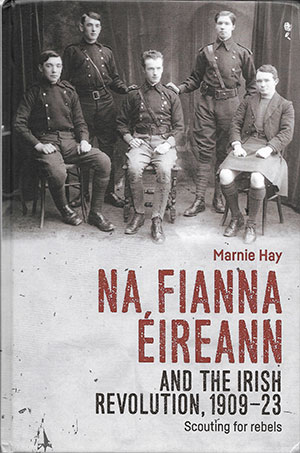NA FIANNA ÉIREANN AND THE IRISH REVOLUTION, 1909–23: scouting for rebels
Published in Book Reviews, Book Reviews, Issue 6 (November/December 2019), Volume 27MARNIE HAY
Manchester University Press
£80
ISBN 9780719096839
Reviewed by Angus Mitchell
Angus Mitchell is a historian and lives in Limerick.
 The opening of the archives of the Bureau of Military History and the Military Service Pensions Collection has provided a new quarry of evidence to allow deeper scrutiny of the organisational structures and networks of the Irish Revolution. Using these resources, Marnie Hay’s history of Na Fianna Éireann (‘soldiers of Ireland’) provides a scholarly and accessible account of the national youth organisation’s early history.
The opening of the archives of the Bureau of Military History and the Military Service Pensions Collection has provided a new quarry of evidence to allow deeper scrutiny of the organisational structures and networks of the Irish Revolution. Using these resources, Marnie Hay’s history of Na Fianna Éireann (‘soldiers of Ireland’) provides a scholarly and accessible account of the national youth organisation’s early history.
Initial chapters plot the development of Na Fianna in the seven years before the Rising. Hay maps the shift from a nationalist scouting movement with strong links to the Gaelic League to a military training body that fed recruits first into the IRB and later into the Irish Volunteers, Irish Citizen Army and IRA. After 1922, although a majority of Na Fianna Éireann opposed the treaty, various members found careers in the Irish Defence Forces and An Garda Síochána. In later chapters Hay employs a thematic approach to explore who joined Na Fianna and the ‘experience’ of belonging to such a movement.
The recognised founders, Countess Markiewicz and Bulmer Hobson, were in many ways an odd couple. Markiewicz remains the embodiment of the militarised woman yet she encouraged few girls to join the ranks. Hobson, in contrast, is still widely dismissed for his opposition to the Rising. Hay builds here on her biography of Hobson (reviewed in HI 17.5, Sept./Oct. 2009), sketching a profile of the man who did more than any other individual leader to prepare the ground for open rebellion despite his inherent pacifist views.
Hay makes little of the fact that Hobson had set up the earliest incarnation of Na Fianna in Belfast in June 1902 and does not engage with Seán Worgan’s indispensable recent study, Bulmer Hobson: an Ulster nationalist, 1902–1908 (2015). This is unfortunate, as Worgan’s research has contributed immensely to understanding Hobson’s political and radical formation. He demonstrates how Hobson’s socialism and republicanism were rooted in his Quaker background, his mother’s reading circle and his identification with the achievement of the Italian politician and activist Giuseppe Mazzini. Scrutiny of Hobson’s writings confirm how his intellectual engagement ranged widely between a lifelong interest in economics, collectivism, social justice, psychology and the esoteric.
The Hobson–Markiewicz collaboration was ignited by their mutual interest in E.T. Craig’s A history of Ralahine, the experimental community in east Clare. Along with Helena Molony, Hobson and Markiewicz set up an experimental agricultural commune in Belcamp Park near Dublin. In the grounds surrounding the big house they encouraged young Fianna to practise basic outdoor skills such as lighting fires, shooting and camping.
From late 1909 new sluaighte (troops) were rolled out around the country, and a formidable organisation evolved in terms of structure, purpose, policies, membership and geographical spread. A constitution was developed at an annual ard-fheis. By 1912 Hobson had started to fuse Na Fianna into the wider revolutionary circuitry, and more formal military instruction was encouraged. This is evident in the Fianna Handbook (1914), a manual for young republican revolutionaries. Two of Na Fianna’s most able officers, Con Colbert and Seán Heuston, were executed in Kilmainham. Other notable warriors included Liam Mellowes and Pádraic Ó Riain. Hay provides three valuable appendices listing those members of Na Fianna whose lives and testimonies tell us most about the movement.
Another requirement of Na Fianna was to keep communication channels open and fluid. Members were deployed to distribute advanced nationalist, republican and socialist newspapers and anti-recruitment literature, and to gather intelligence vital to Volunteer operations. News about Na Fianna was carried in the columns of the underground press: Bean na hÉireann, Irish Freedom, the Irish Volunteer and Fianna. Since Hobson’s invisible hand was involved in the editorial production of each of these newspapers, it is apparent that Na Fianna were indispensable to a broader propaganda strategy in those early years.
After the Rising and with Hobson on the run, Markiewicz became the dominant figure. She deployed the organisation in more direct political campaigning for Sinn Féin during the 1918 election. Throughout the War of Independence, Fianna recruits took ever more active—and sometimes violent—roles. Tensions occasionally emerged with the IRA owing to lack of communication about planned operations.
Valuable sections on questions to do with education and culture give an insight into how a key element of the nationalist mentality was shaped. The teaching of history and myth, the place of song and music, and even the production of plays were all part of a vitalised re-education programme. Such activities added an imaginative dynamic that lends a progressive identity to the organisation that is often overlooked.
If developing the physical prowess of the youth of Ireland was important, the early emergence of Na Fianna was as much a product of the creative forces of the Cultural Revival as it was a reaction to the British Empire’s preparation of boys for war. Na Fianna were part of the new architecture of a nation in the making. Through their ranks pulsed the structure of feeling and that sense of voluntary purpose, solidarity and camaraderie that proved intrinsic to the eventual delivery of independence.
















